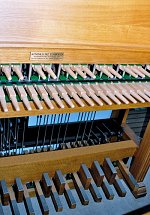
GDANSK - On the occasion of the 15th World Congress in Gdansk, the Committee of Delegates of the WCF accepted on July 18, 2006, the report of the WCF Keyboard Committee. The acceptance of this report means that the World Carillon Federation finally reached consensus on technical norms for a third keyboard standard to stand alongside, and as representing the best currently available compromise between, the existing North American (GCNA, 1981) and North European (1983) keyboard standards. All significant measurements of the keyboard are clearly listed.
Two years ago, in Oslo, the Committee of Delegates adopted a motion asking the WCF Keyboard Committee to try to reach an agreement on norms for a world standard for the carillon keyboard. At the time it was already clear that it would be best to allow some measurements to be variable, since the weight of an instrument and the construction and location of a tower are never the same.
The work of the committee resulted in a proposal that was presented for adoption to the Committee of Delegates during the World Congress in Gdansk. The norms were derived from the so-called Keyboard 2000, designed by Richard Strauss. In the process the measurements of all hybrid keyboards that have been built during the past twenty years were taken into consideration.
An official document containing the measurements of the new keyboard is now available as a PDF-document. It includes a few comments and a brief history of the development of the WCF Keyboard 2006. This document and the drawing of the keyboard can be freely used by anyone who wants to build a carillon keyboard.
: Technical norms of the WCF Keyboard 2006 
: Drawing of the WCF Keyboard 2006 
: Comparative measurements of hybrid keyboards 
: History of the Keyboard 2000 
Current users of both the North American and the North European standard will feel comfortable with the amended Keyboard 2000 design. For Europeans, the center to center manual key distances remain the same. American players will encounter the same pedal-manual axis of b1 under d3, as well as the concave and radial pedal.
Sufficient flexibility has been allowed in the specifications of the WCF Keyboard 2006 to fit varied circumstances. There is no intention to eliminate historic keyboards of the past, but to provide guidelines for newly-built instruments and renovations where desired.
With the dedicated work of the WCF Keyboard Committee and the courageous decision of the Committee of Delegates an important contribution has been made to the goals of the WCF.
APPENDIX
1. The WCF recognizes the existing GCNA keyboard standard and the existing North European keyboard standard, and accepts the report and proposed standard from the Keyboard Committee of Gdansk 2006 as the then best available compromise between the GCNA and North European standards.
2. The WCF encourages continued study of how best to refine, harmonize and adapt the recognized keyboard standards.
3. The WCF recommends that for new carillon installations or for major renovations of existing carillons, the selection of the keyboard standard to be followed and the determination of variations from that standard appropriate to the unique characteristics of the particular instrument should be made by a qualified independent consultant (jointly with the currently appointed carillonneur, if one exists).
